Ever wanted to see Rome, and also take in Assisi and Manhattan – all in the space of one day? There is one way of achieving such an apparently impossible feat. Marc Zakian takes the underground out to Cinecittà…
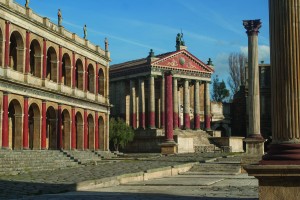
Last stop but one on the Rome underground line is Cinecittà. This is Cinema City: not a simple Hollywood, or a lonely Pinetree, but an entire metropolis dedicated to movie magic. Twenty years ago I lived in the capital and longed to visit, but back then it was a forbidden city where only the chosen entered. Two decades later I am stepping out of the metro at the distinctly non-showbiz tube stop bearing Cinecittà’s name, and heading through the main entrance. The studios now welcome paying visitors, and I join a group of film fans eager to discover the secrets of Rome’s ‘Hollywood on the Tiber’.
Cinecittà’s main square features a sedate green lawn shaded by umbrella pines and enclosed by mustard coloured walls. I was expecting to be greeted by a riot of clapper boards, costumed extras, pampered stars and screaming producers. But now we mortals are allowed through the front door, while the talent comes in round the back.
Our guide, Roberta, ushers us onto the back lot. We are on ‘Broadway’: four streets built in 2002 for the film Gangs of New York – and left here as a permanent legacy. This is Manhattan in the 1850s, with gas lamps, shops and houses – I peek behind the doors in search of fast-talking New Yorkers, but the only residents are noonday lizards basking in the grass.
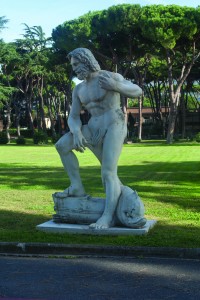
Left off ‘Broadway’ is the Roman forum. Here is Caesar’s city, but not as you know it (if you want the real one, it’s four miles down the road). For years my route to work took me past the bleached white marble ruins of the ancient Roman capital. But this is the imperial city as the builders left it: the temple of Venus with its bright-red columns waiting for a Nero to stride between them; a pristine green victory god ready to fly from its column.
There are five acres of the ancient capital reconstructed here in deliciously crafted detail. This is what Cinecittà is famous for: widescreen toga-epics bankrolled by the Hollywood money which flowed up the Tiber during the 1960s – the days when old school screen stars were seduced by the sunshine and pasta lifestyle. Richard Burton met Elizabeth Taylor for Anthony and Cleopatra at Cinecittà; during the filming of the most expensive film in history they fell in love and – as both were already married – caused an international scandal.
“This is where I would like to have lived,” Roberta announces, pointing to an arcaded building with statues and grand columns. “In the patrician villa. As a Roman aristocrat. But of course I would most probably have been over here.” She leads us along the ‘via Appia’ and we are in Suburra, the world’s first suburbs. With my grasp on reality beginning to slip, I give the temple of Venus a quick knock and a hollow plaster sound assures me that this is all part of the business of show.
But despite my reality check, any sense of geography and time flies out of one of the many false studio windows that surround us: in a corner of ‘Rome’ is an ancient Egyptian Temple; beyond is a replica of the St Peter’s balcony; past this is a Renaissance street which leads us back to a medieval town. And not just any medieval town: here is a perfect replica of Assisi from the 1100s, created in a hurry for a drama about St Francis. Rome may not have been built in a day, but
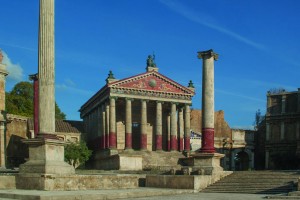
lacking in the ancient original
Cinecitta’s Assisi was constructed in a plaster and fibreglass flurry of 15 days.
As we walk on a figure of Christ greets us. The statue, which was flown over Rome by helicopter for the opening sequence of La Dolce Vita, is part of a collection of divinely crafted props made by the Di Anglis family. Adriano, the third generation master prop maker, pokes his head out from the jumble of movie treasures and invites us in.
The interior resembles a museum rather than model-maker’s workshop. “These were the dolphins on the Ben-Hur chariot,” he explains. “Here is our life-size reproduction of Michelangelo’s David, and this… this I can’t remember what it was for. My father made it,” he recalls, nostalgically pointing to a giant Pharaoh.
We finish at Sound Stage 5, the spiritual home of Cinecittà’s maestro, Federico Fellini. Most of the director’s films were shot here, and the imposing 1930s concrete studio is the largest ever built in Europe. Fellini loved the studios; he worked, slept and ate there. And when he died, people paid their respects at his coffin in Studio 5.
Carole Andrè-Smith acted for Fellini. “The director was friendly with my mother,” she tells me. “He was making Satyricon and had to shoot a scene where two boys kiss each other. It was 1969, Italy was much more conservative then, and the Maestro felt it would be easier to use a boy and a girl. So there I was, age 15 dressed up as a boy. A woman watching the filming said to my mother ‘What a handsome son you have.’”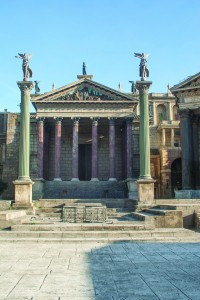
“I first came here as a very young girl. My French-American mother played foreign roles in Italian films and she would bring me on set. I was always happy at Cinecittà. It felt like I was in another dimension, where crazy things were normal.
“The dressing rooms were enormous areas of exciting activity. I would walk past each studio, enchanted by the music and bustle. Outside the wardrobe area they were dying costumes with tea bags then hanging them out in the sun to dry. It was a place of contrasts: over here was a naked woman, over there Holy Jerusalem. When Mel Gibson made The Passion of the Christ at Cinecittà there were thousands of olive trees everywhere. It was magical.
“One of my favourite actors was Marcello Mastroianni. He was my ‘protector’ in a film called Dirty Weekend. There is a scene where Oliver Reed had to push himself on me. It was very violent, and when Mastroianni saw I was scared he stopped the filming.”
Carole is still working at Cinecittà, in charge of the studio’s PR. “We make a lot of TV now,” she explains. “BBC/HBO filmed the series Rome here in 2007, leaving us the legacy of their marvelous set. The BBC reused it in 2008 for an episode of Doctor Who located in ancient Last stop but one on the Rome underground line is Cinecittà. This is Cinema City: not a simple Hollywood, or a lonely Pinetree, but an entire metropolis dedicated to movie magic. Twenty years ago I lived in the capital and longed to visit, but back then it was a forbidden city where only the chosen entered. Two decades later I am stepping out of the metro at the distinctly non-showbiz tube stop bearing Cinecittà’s name, and heading through the main entrance. The studios now welcome paying visitors, and I join a group of film fans eager to discover the secrets of Rome’s ‘Hollywood on the Tiber’.
Cinecittà’s main square features a sedate green lawn shaded by umbrella pines and enclosed by mustard coloured walls. I was expecting to be greeted by a riot of clapper boards, costumed extras, pampered stars and screaming producers. But now we mortals are allowed through the front door, while the talent comes in round the back.
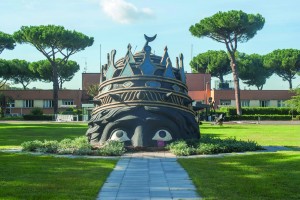
Our guide, Roberta, ushers us onto the back lot. We are on ‘Broadway’: four streets built in 2002 for the film Gangs of New York – and left here as a permanent legacy. This is Manhattan in the 1850s, with gas lamps, shops and houses – I peek behind the doors in search of fast-talking New Yorkers, but the only residents are noonday lizards basking in the grass.
Left off ‘Broadway’ is the Roman forum. Here is Caesar’s city, but not as you know it (if you want the real one, it’s four miles down the road). For years my route to work took me past the bleached white marble ruins of the ancient Roman capital. But this is the imperial city as the builders left it: the temple of Venus with its bright-red columns waiting for a Nero to stride between them; a pristine green victory god ready to fly from its column.
There are five acres of the ancient capital reconstructed here in deliciously crafted detail. This is what Cinecittà is famous for: widescreen toga-epics bankrolled by the Hollywood money which flowed up the Tiber during the 1960s – the days when old school screen stars were seduced by the sunshine and pasta lifestyle. Richard Burton met Elizabeth Taylor for Anthony and Cleopatra at Cinecittà; during the filming of the most expensive film in history they fell in love and – as both were already married – caused an international scandal.
“This is where I would like to have lived,” Roberta announces, pointing to an arcaded building with statues and grand columns. “In the patrician villa. As a Roman aristocrat. But of course I would most probably have been over here.” She leads us along the ‘via Appia’ and we are in Suburra, the world’s first suburbs. With my grasp on reality beginning to slip, I give the temple of Venus a quick knock and a hollow plaster sound assures me that this is all part of the business of show.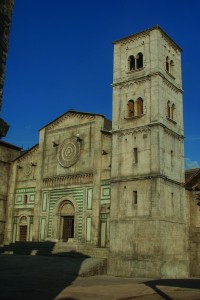
But despite my reality check, any sense of geography and time flies out of one of the many false studio windows that surround us: in a corner of ‘Rome’ is an ancient Egyptian Temple; beyond is a replica of the St Peter’s balcony; past this is a Renaissance street which leads us back to a medieval town. And not just any medieval town: here is a perfect replica of Assisi from the 1100s, created in a hurry for a drama about St Francis. Rome may not have been built in a day, but Cinecitta’s Assisi was constructed in a plaster and fibreglass flurry of 15 days.
As we walk on a figure of Christ greets us. The statue, which was flown over Rome by helicopter for the opening sequence of La Dolce Vita, is part of a collection of divinely crafted props made by the Di Anglis family. Adriano, the third generation master prop maker, pokes his head out from the jumble of movie treasures and invites us in.
The interior resembles a museum rather than model-maker’s workshop. “These were the dolphins on the Ben-Hur chariot,” he explains. “Here is our life-size reproduction of Michelangelo’s David, and this… this I can’t remember what it was for. My father made it,” he recalls, nostalgically pointing to a giant Pharaoh.
We finish at Sound Stage 5, the spiritual home of Cinecittà’s maestro, Federico Fellini. Most of the director’s films were shot here, and the imposing 1930s concrete studio is the largest ever built in Europe. Fellini loved the studios; he worked, slept and ate there. And when he died, people paid their respects at his coffin in Studio 5.
Carole Andrè-Smith acted for Fellini. “The director was friendly with my mother,” she tells me. “He was making Satyricon and had to shoot a scene where two boys kiss each other. It was 1969, Italy was much more conservative then, and the Maestro felt it would be easier to use a boy and a girl. So there I was, age 15 dressed up as a boy. A woman watching the filming said to my mother ‘What a handsome son you have.’”
“I first came here as a very young girl. My French-American mother played foreign roles in Italian films and she would bring me on set. I was always happy at 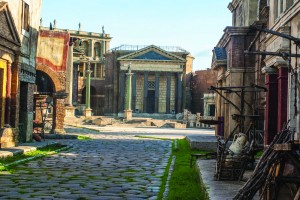 Cinecittà. It felt like I was in another dimension, where crazy things were normal.
Cinecittà. It felt like I was in another dimension, where crazy things were normal.
“The dressing rooms were enormous areas of exciting activity. I would walk past each studio, enchanted by the music and bustle. Outside the wardrobe area they were dying costumes with tea bags then hanging them out in the sun to dry. It was a place of contrasts: over here was a naked woman, over there Holy Jerusalem. When Mel Gibson made The Passion of the Christ at Cinecittà there were thousands of olive trees everywhere. It was magical.
“One of my favourite actors was Marcello Mastroianni. He was my ‘protector’ in a film called Dirty Weekend. There is a scene where Oliver Reed had to push himself on me. It was very violent, and when Mastroianni saw I was scared he stopped the filming.”
Carole is still working at Cinecittà, in charge of the studio’s PR. “We make a lot of TV now,” she explains. “BBC/HBO filmed the series Rome here in 2007, leaving us the legacy of their marvelous set. The BBC reused it in 2008 for an episode of Doctor Who located in ancient Pompeii. We have even been the home to the Italian Grande Fratello (Big Brother). But my hope is that a ‘new Fellini’ will come here and bring the cinematic magic back to Cinecittà.”
I decide to pay homage to the original Fellini and head to the city centre – to the fountain that was built by a Pope and made famous by a film (and a song). In La Dolce Vita Marcello Mastroanni is tempted to wade into the waters of the Trevi Fountain by the siren Anita Ekberg – nobody sees them splashing about, except for a kitten, which Ekberg balances on her head.
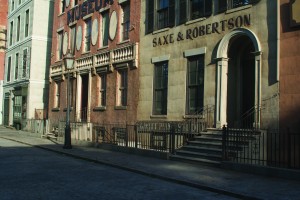
When I arrive in a packed Trevi Square there’s no room to swing a Fellini kitten. Legend says that if you throw a coin in the fountain you will return to Rome. But most people can’t get close to the waters so they launch their coins over the masses below: euros, dimes and pennies whistle perilously past the heads of tourists, startling the thirsty pigeons perched on the monument. Polaroid photographers try to sell their instant pictures to a digital generation, while a local down-and-out plucks a living from the fountain’s riches with a magnet on a stick. A policeman who should stop him from raiding the Trevi’s booty chats on his mobile.
If Fellini were alive today, he would love every moment. Rome is pure cinema.
THE INSIDE TRACK
➤ Cinecittà is open every day from 9.30am until 5.30 pm (except Tuesdays). Studio tours leave at 11.30 and 15.30 (in both Italian and English). There is also a museum which includes costumes worn in famous films by Donald Southerland, Liza Minella and Sophia Loren. The exhibition also features an audio visual display on the making of films, and a section of submarine made for the war film U-571. Tickets for both the museum and tour are €20/£15 (€15/£12 concessions). Allow at least an hour for the museum visit.
➤ Ask your guide to point out the Ben-Hur chariot and the Fellini Christ statue. There is not much to see or do in the immediate area around Cinecittà studios, so plan your visit to coincide with the tour. There is a café bar inside the studio complex, but no full restaurant.
GETTING THERE
➤ British Airways offers daily flights from Heathrow and Gatwick to Rome Fiumicino from £90 return.
➤ To get to Cinecittà itself, take the underground line A from the centre of Rome in the direction of Anagnina. Metro tickets €1.50/£1.20. Get off at Cinecittà and you will see the studios as you exit the station.
WHERE TO STAY
➤ Hotel Borgognoni
Centrally located – a short walk to the Spanish Steps and Trevi Fountain – this hotel is old school without being stuffy, classic without being dusty. Velvets, marbles, wood panelling and classic prints blend together to give a sense of history. The charming staff could be taken from a ‘60s film. Good buffet breakfast in the hotel – no restaurant but there is an infinity of places to eat nearby. It is a short walk to the underground that takes you to Cinecittà. Doubles from €180/£160.
